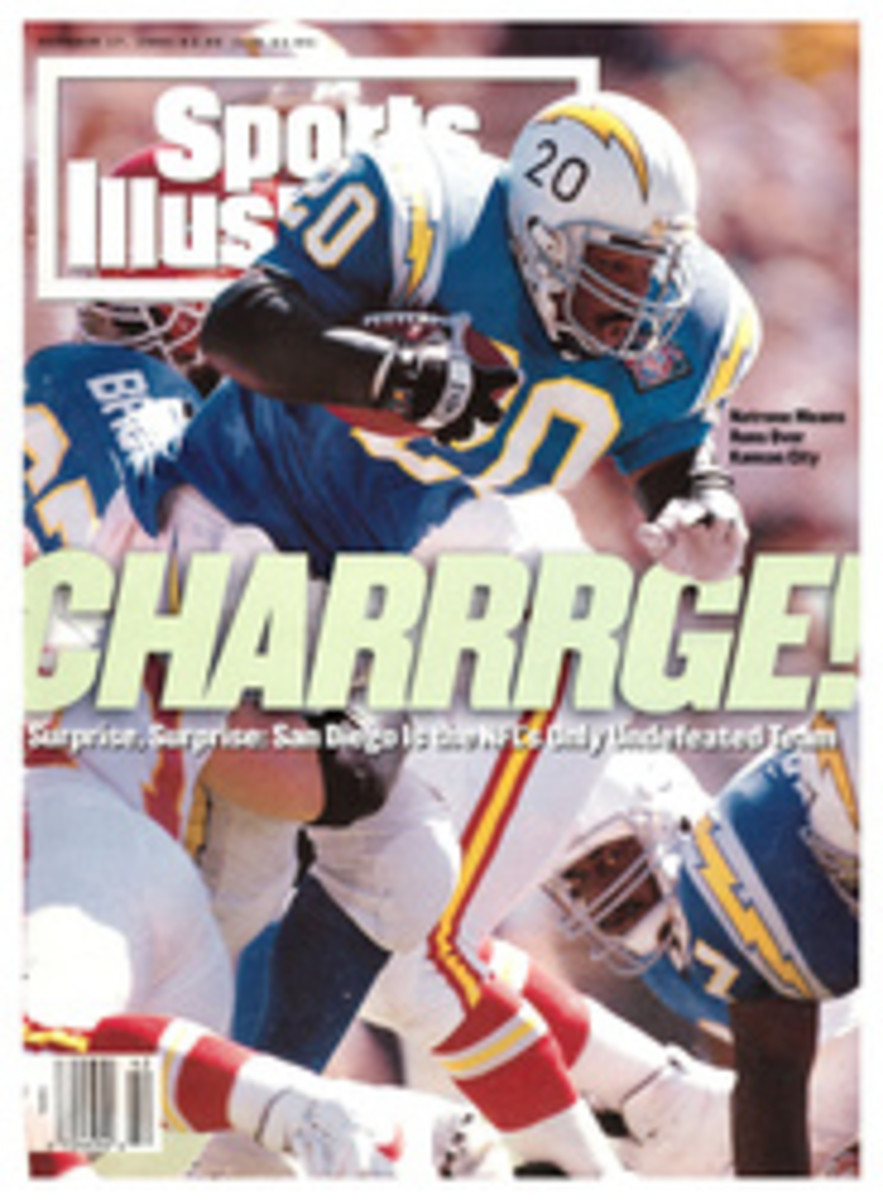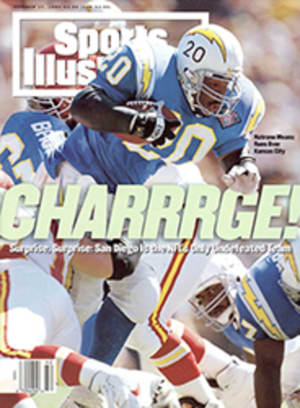
Wagon Strain
Pure Hollywood, circa 1959. A cloudless early-September sky. A flat valley ringed by green mountains. In a vast camp in the distance, hundreds of horses graze amid the hazy columns rising from cook fires. From the east comes a creaking and a rumbling, a whooping and hollering. Wooden wagons race across the grassy plain, then circle a lone walnut tree. Iron skillets clank. Drivers and outriders lose cowboy hats at every bounce.
Billows of dust rise to the top of a sandstone bluff separated from the scene by the South Fork of the Little Red River. There, standing at the edge of the cliff like the entire Navajo nation. 5,000 mute figures watch the action unfold below.
Welcome to the backyard of Dan and Peggy Eoff. Welcome to the Ninth Annual National Championship Chuckwagon Races.
The Eoffs devote their entire spread in Clinton, Ark. (no relation), to the races: 315 acres of racecourses; parking lots for spectators; a concession area larger than those of some county fairs; two campgrounds for wagon drivers, their families and horses; and the bluff, which provides a CinemaScope view from the comfort of a spectator's own lawn chair.
In the concession area one may buy lariats, saddles, cowboy hats, fried onion blossoms, plastic tornado shelters (with room for a family of seven), more hats, Western earrings, bolas, hand-scrolled leather belts, bull skulls embossed with the image of John Wayne as he appeared in the 1959 Western Rio Bravo, more hats, turkey jerky, chaps, snow cones, funnel cakes and still more hats.
On race weekend each day's activities begin when Dan picks up a microphone, switches off the canned country and announces. "Gentlemen, please remove cover for prayer and our national anthem." This is a country crowd. During the prayer the only sounds other than Dan's gravelly voice are the distant neighing of horses and the whisper of warm breezes coursing up the bluff and through the pines. A trumpet player—you would swear from his nervous expression that he is Floyd the barber or maybe Goober cleaned up for the occasion—blows a surprisingly haunting rendition of The Star-Spangled Banner. Despite a couple of flubbed notes, or perhaps because of them, you feel yourself sucked into the production. The wagons begin to look grand as they roll around for the opening parade. The mustached men and pony-tailed women perched on the wagons look somehow noble, true. Hollywood or not, the spectacle is wondrous to behold.
"It started out as just a party," says Peggy Eoff of the event that this year drew 152 wagon teams and an estimated 15,000 to 20,000 spectators over the Labor Day weekend. "After we got married, in 1986, we were invited to several big get-togethers at other ranches. Our house was a lot smaller then, and it was kind of our turn. So we decided to do something outside for Labor Day. This was it."
Peggy, 37, and Dan, 45, could almost pass for Angie Dickinson and John Wayne in Rio Bravo. She's compact and blonde and favors red-checkered blouses. He's tall, broad and bigger than life beneath a 10-gallon hat. Together they operate the Bar of Ranch and, in Clinton, the Bar of Feed Store.
"Dan's not the type to sit around and eat and drink beer and talk about stuff," Peggy continues. "He wants to get up and do something, maybe then sit around and talk about it. Well, we'd just been to the Cheyenne Frontier Days Festival and seen some wagon races. So Dan called up everyone he knew and said. "Bring your wagons over Labor Day, and we'll have us a big race.' "
The Eoffs expected 100 visitors that first race weekend, but about 500 showed up. Sensing that they might be on to something, the Eoffs began advertising, charging spectators for admission and renting food concessions to what they called the Arkansas Championship Chuckwagon Race.
When, three years ago, the event began drawing more team entries than any other organized wagon race, Dan had a new sign painted: THE NATIONAL CHAMPIONSHIP CHUCKWAGON RACES. Budweiser, several feed manufacturers and, later, Chevrolet signed on as sponsors, and a new, wooden-wheeled NASCAR was born. The 1994 event offered competitors a chance at a share of $17,500 worth of prizes, including saddles and big flashy belt buckles.
In addition to wagon races, on each of the three days there is a free-for-all stampede called the Snowy River Race, in which riders on horseback—many mounted on racing thoroughbreds—career down a steep hillside and then splash through the South Fork of the Little Red River, re-creating the climactic scene of a 1982 movie, The Man from Snowy River.
The wagon races themselves are split into five divisions: pony mules, ponies, big mules, the Oklahoma Land Rush—which re-creates a historic American event—and the Classic, featuring authentic wooden-wheeled wagons pulled by two-horse teams. Wagons in the smaller divisions are typically constructed of welded steel, with steel-belted radial tires. In the Classic race, generally considered the highlight of the weekend, all wagons must fit certain construction requirements and carry a wooden water barrel, a toolbox, a lantern, a skillet and a coffeepot.
Races are run in four-wagon heats, with all wagons racing on all three days. The best time out of the three days in each division wins. All events except the Oklahoma Land Rush and the Snowy River Race follow the same half-mile course, which circles a barrel, follows a straightaway of about 100 yards, circles left at a specified walnut tree to follow a marked course, then comes back down a backstretch of about 50 yards to end at the same walnut tree. Small, light teams can circle the course in less than 50 seconds, but the Classic wagons—which weigh 1,000 pounds or more—seldom make it in under a minute.
A chuckwagon team consists of three members: the driver, the cook and the outrider. The driver's job is pretty much what you would expect; the duties of the other two members aren't so obvious.
Before the gun goes off, the cook must load the "tent" (usually a roll of canvas), jump in beside the driver and help yell at the horses. He or she also keeps an eye on the competition and on the team's outrider during the race.
The outrider may have the most difficult job of all. At the start, he or she flings a "stove"—usually a black tin or cardboard box—into the wagon bed. As the wagon pulls out, the outrider must mount a horse, round a barrel, and catch and pass the wagon before it crosses the finish line or the team is disqualified.
By the start of the final day of the Ninth Annual National Championship, three Arkansas teams were tied for first place in the Classic division at 58 seconds even: the Bar X, from Atkins; the Fourche Mountain Rough Riders, from Plainview; and a team called simply the Cowboys, from Grapevine. "The competition's really tough this year." complained Todd Carter, the Rough Riders' driver, 30 minutes before the start of the Classic heats, "I think this is the closest it's ever been. Everybody's putting a lot of money and energy into getting that belt buckle."
The competition was tough indeed. Fighting for the advantage heading into the first curve of the sixth race, the wagon operated by a team called the County Line Bunch rolled. The wooden box separated from the chassis and flipped, breaking driver David French's pelvis in four places.
In another heat a team of horses became tangled in each other's traces and skidded 40 feet, digging a dirt trench that looked like a plane-crash site. Miraculously, the horses stood unhurt after their harnesses were cut from them.
By the eighth race no one had improved upon the 58-second best time. The Eoffs and the judges decided to break the tie with a shortened race among the three leaders. They would round the first barrel, then make a dash for the Oklahoma Land Rush finish line, avoiding the dangerous curves of the back course.
Because of the shorter distance, the rule requiring the outrider to pass the team was suspended. The first wagon across with stove and tent inside would take all. Both Bar X and the Cowboys were slow from the gun, and the Fourche Mountain Rough Riders established an early, decisive lead. Carter was able to wear his prize buckle back to Plainview.
Pure Hollywood or not, the spectacle was wondrous to behold.
PHOTO
PHIL HUBER
In this year's Classic, the Fourche Mountain Rough Riders tried to leave all other wagons in the dust.
PHOTO
PHIL HUBER
The Snowy River Race, a dash-and-splash free-for-all on horseback, is literally out of the movies.
Michael Ray Taylor leaches journalism at Henderson Stale University in Arkadelphia, Ark.

